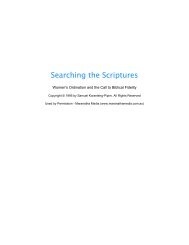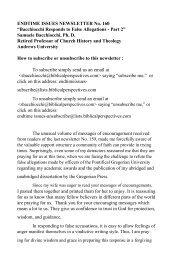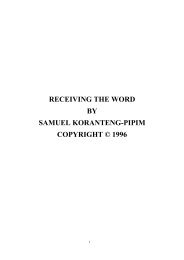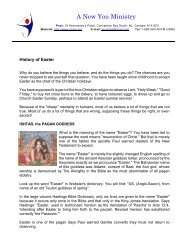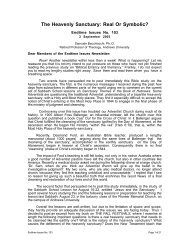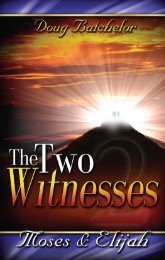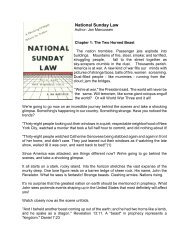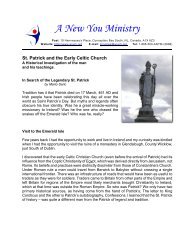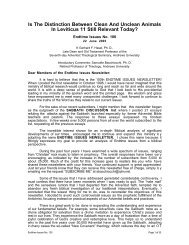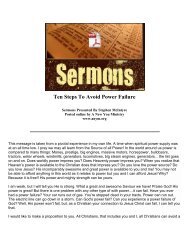Bible Readings for the Home Circleâ1914 - A New You Ministry
Bible Readings for the Home Circleâ1914 - A New You Ministry
Bible Readings for the Home Circleâ1914 - A New You Ministry
You also want an ePaper? Increase the reach of your titles
YUMPU automatically turns print PDFs into web optimized ePapers that Google loves.
BIBLE READINGS<br />
those who embraced it, only assumed <strong>the</strong> name, received <strong>the</strong> rite of<br />
baptism, and con<strong>for</strong>med to some of <strong>the</strong> external ceremonies of <strong>the</strong><br />
church, while at heart and in moral character <strong>the</strong>y were as much hea<strong>the</strong>n<br />
as <strong>the</strong>y were be<strong>for</strong>e. Error and corruption now came in upon <strong>the</strong><br />
church like a flood.”<br />
7. What were <strong>the</strong> color and character of <strong>the</strong> fourth symbol<br />
“And when He had opened <strong>the</strong> fourth seal. . . . behold a pale horse:<br />
and his name that sat on him was Death, and Hell [Greek, Hades, <strong>the</strong><br />
grave] followed with him. And power was given unto <strong>the</strong>m over <strong>the</strong> fourth<br />
part of <strong>the</strong> earth, to kill with sword, and with hunger, and with death, and<br />
with <strong>the</strong> beasts of <strong>the</strong> earth.” Verses 7, 8.<br />
NOTE.— This is an unnatural color <strong>for</strong> a horse. The original denotes<br />
<strong>the</strong> pale or yellowish color seen in blighted plants. The symbol evidently<br />
refers to <strong>the</strong> work of persecution and death carried on by <strong>the</strong><br />
Roman Church against <strong>the</strong> people of God from <strong>the</strong> time of <strong>the</strong> beginning<br />
of papal supremacy in 538 A.D. to <strong>the</strong> time when <strong>the</strong> Re<strong>for</strong>mers<br />
commenced <strong>the</strong>ir work of exposing <strong>the</strong> true character of <strong>the</strong> Papacy,<br />
and a check was placed upon this work of death.<br />
8. On opening <strong>the</strong> fifth seal, what was seen under <strong>the</strong> altar {286<br />
286}<br />
“And when He had opened <strong>the</strong> fifth seal, I saw under <strong>the</strong> altar <strong>the</strong><br />
souls of <strong>the</strong>m that were slain <strong>for</strong> <strong>the</strong> word of God, and <strong>for</strong> <strong>the</strong> testimony<br />
which <strong>the</strong>y held.” Verse 9.<br />
NOTE.— When <strong>the</strong> Re<strong>for</strong>mers exposed <strong>the</strong> work of <strong>the</strong> Papacy, it was<br />
<strong>the</strong>n called to mind how many martyrs had been slain <strong>for</strong> <strong>the</strong>ir faith.<br />
9. What were <strong>the</strong>se martyrs represented as doing<br />
“And <strong>the</strong>y cried with a loud voice, saying, How long, O Lord, holy<br />
and true, dost Thou not judge and avenge our blood on <strong>the</strong>m that dwell on<br />
<strong>the</strong> earth” Verse 10.<br />
NOTE.— The cruel treatment which <strong>the</strong>y had received cried <strong>for</strong> vengeance,<br />
just as Abel’s blood cried to God from <strong>the</strong> ground. Gen. 4:10.<br />
They were not in heaven, but under <strong>the</strong> altar on which <strong>the</strong>y had been<br />
slain. On this point Dr. Adam Clarke says: “The altar is upon earth, not<br />
in heaven.” See note under next question.<br />
10. What was given <strong>the</strong>se martyrs<br />
“And white robes were given unto every one of <strong>the</strong>m; and it was said<br />
unto <strong>the</strong>m, that <strong>the</strong>y should rest yet <strong>for</strong> a little season, until <strong>the</strong>ir fellow<br />
servants also and <strong>the</strong>ir brethren, that should be killed as <strong>the</strong>y were, should<br />
be fulfilled [have fulfilled <strong>the</strong>ir course, R. V.].” Verse 11.<br />
NOTE.— These had been slain during <strong>the</strong> hundreds of years covered<br />
by <strong>the</strong> preceding seal. Their persecutors, most of <strong>the</strong>m, at least, had<br />
died. And if <strong>the</strong>y had at death passed to <strong>the</strong>ir punishment, as is by<br />
some supposed, why should <strong>the</strong> martyred ones still importune <strong>for</strong><br />
<strong>the</strong>ir punishment In this, as in o<strong>the</strong>r parts of <strong>the</strong> <strong>Bible</strong>, <strong>the</strong> figure of<br />
THE SEVEN SEALS<br />
personification is used, in which inanimate objects are represented as<br />
alive and speaking, and things that are not as though <strong>the</strong>y were. See<br />
Judges 9:8–15; Heb. 2:11; 4; Rom. 4:17. These martyrs had gone down<br />
as heretics under <strong>the</strong> darkness and superstition of <strong>the</strong> preceding seal,<br />
covered with ignominy and shame. Now, in <strong>the</strong> light of <strong>the</strong> Re<strong>for</strong>mation,<br />
<strong>the</strong>ir true character appears, and <strong>the</strong>y are seen to have been<br />
righteous, and hence are given “white robes.” “The fine linen [white<br />
robes] is <strong>the</strong> righteousness of saints.” Rev. 19:8. Righteousness is<br />
ascribed to <strong>the</strong>m; and when <strong>the</strong>y have rested a little longer where <strong>the</strong>y<br />
are,—under <strong>the</strong> altar,—till all o<strong>the</strong>rs who are to fall <strong>for</strong> <strong>the</strong>ir faith have<br />
followed <strong>the</strong>m, <strong>the</strong>n toge<strong>the</strong>r <strong>the</strong>y will be raised to life and immortality.<br />
11. What was first seen on <strong>the</strong> opening of <strong>the</strong> sixth seal.<br />
“And I beheld when He had opened <strong>the</strong> sixth seal, and, lo, <strong>the</strong>re was a<br />
great earthquake.” Verse 12, first part.<br />
NOTE.— This doubtless refers to <strong>the</strong> great earthquake of Nov. 1, 1755,<br />
commonly known as <strong>the</strong> Lisbon earthquake, <strong>the</strong> effects of which were<br />
felt over an area of 4,000,000 square miles: Lisbon, Portugal, a city<br />
containing 150,000 inhabitants was almost entirely destroyed. The<br />
shock of <strong>the</strong> earthquake, says Mr. Sears, in his “Wonders of <strong>the</strong> World,”<br />
page 200, “was instantly followed by <strong>the</strong> fall of every church and<br />
convent, almost all <strong>the</strong> large public buildings, and one fourth of <strong>the</strong><br />
houses. In about two hours afterward, fires broke out in different quarters,<br />
and raged with such {287<br />
287} violence <strong>for</strong> <strong>the</strong> space of nearly<br />
three days that <strong>the</strong> city was completely desolated. The earthquake<br />
happened on a holy day, when <strong>the</strong> churches and convents were full of<br />
people, very few of whom escaped. . . . The terror of <strong>the</strong> people was<br />
beyond description. Nobody wept: it was beyond tears. They ran<br />
hi<strong>the</strong>r and thi<strong>the</strong>r, delirious with horror and astonishment, beating<br />
<strong>the</strong>ir faces and breasts, crying, ‘Misericordia! <strong>the</strong> world’s at an end!’<br />
Mo<strong>the</strong>rs <strong>for</strong>got <strong>the</strong>ir children, and ran about loaded with crucifixed<br />
images. Un<strong>for</strong>tunately, many ran to <strong>the</strong> churches <strong>for</strong> protection; but in<br />
vain was <strong>the</strong> sacrament exposed; in vain did <strong>the</strong> poor creatures embrace<br />
<strong>the</strong> altars; images, priests, and people were buried in one common<br />
ruin. . . . Ninety thousand persons are supposed to have been lost<br />
on that fatal day.”<br />
12. What was to follow <strong>the</strong> great earthquake<br />
“And <strong>the</strong> sun became black as sackcloth of hair, and <strong>the</strong> moon became<br />
as blood.” Same verse, latter part.<br />
NOTE.— This refers to <strong>the</strong> dark day and night of May 19, 1780, when<br />
<strong>the</strong> darkness and gloom were such as to give <strong>the</strong> general impression<br />
that <strong>the</strong> day of judgment was at hand. See readings on pages 311, 319.




